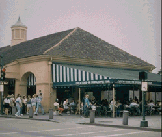Talking that New Orleans Talk

Visit Cafe Dumonde for the best Cafe au LaitNew Orleans has a language all its own. While you're in New Orleans, you will want to know what the locals are talking about ! Listed here are some words and phrases that New Orleanians use that are unique to the Big Easy.
Alligator Pear
What the locals call an avocado.
Andouille - "An Doo E"
This is a traditional New Orleans style, spicy sausage. Usually, andouille is used to make jambalaya, red beans and rice and other New Orleans dishes.
Banquette - "Ban Ket"
In New Orleans, this means, simply, a sidewalk.
Beads
Beads refer to plastic necklaces that are thrown from floats and balconies during Carnival. Plastic beads become a kind of currency during Mardi Gras. People trade and collect beads. People also are know to do some rather outrageous things to acquire beads during Mardi Gras.
Beignet - "Ben Yeah"
These are French style donuts that are drowned in powdered sugar. Usually, beignets are served with cafe au lait. Stop by Cafe Du Monde for the cities best coffee and beignets.
Cafe au Lait - "Ca Fay - Oh - Lay"
This is New Orleans traditional coffee. Cafe au Lait is made from coffee and chickory mixed with boiled milk. Cafe au Lait is certain to give you a start for the new day.
Cajun - "Kay Jen"
There are a three meanings for this word. The first refers to the French Acadians who settled into the bayous of Louisiana from Novia Scotia in the 1700's. The second meaning, which involves a rather hot debate, refers to a style of cooking. The last meaning describes a unique dialect of French spoken by the "cajuns."
Chickory
This is actually a root that is ground and roasted to add flavor to coffee. Cafe au Lait is made with Coffee, chickory and boiled milk.
Crawfish
Crawfish are sort of like little lobsters. Locals have "crawfish parties" where friends gather to feast on pounds and pounds of crawfish that are highly seasoned and boiled with onions, new potatoes, whole garlic cloves, sausage and anything else that adds flavor to these delicious crustaceans. Yankees sometimes call crawfish "crayfish." Locals often refer to crawfish as "mudbugs."
Creole - "Kree Yol"
This word has a rather complicated history. Creole refers to the french and spanish descendents in New Orleans. Creole also describes a style of cooking. The debate regarding the differences between "creole" and "cajun" rages on...
Doubloons
From the tradition of the Spanish pirates comes the doubloon. Doubloons are aluminum coins that are imprinted with the name of a Krewe and the theme of its parade and are thrown from floats during Carnival. Over the years, people have begun to collect and trade doubloons as if they were actual coins. Doubloons are one of the most popular Mardi Gras throws.
Etoufee - "A Two Fay"
There are many variations to this dish. Most etoufees start with a roux and consist of rice, shell fish or meat and vegetable
Flambeaux - "Flam Bo"
Before there were electric lights, Mardi Gras parades were lit by fire torches called flambeaux. Today, the tradition of the flambeaux and their mysterious illumination is carried on by some of the old line Krewes.
Grillades - "Gree Yods"
This is broiled veal served in gravy. Usually, grillades are served for breakfast with grits.
Gumbo
The word "gumbo" comes from an African language that means okra. Gumbo is a traditional southern soup like dish. It can be made with just about anything. But, all gumbos start with a rich roux and usually include either sea food or sausage.
Jambalaya - "Jam Ba Lie Uh"
This is a very popular party dish as it can be made in large quantities ! Usually, jambalaya is a spicy dish made with rice, tomato and either sea food or meat is added for flavor. See the recipe in this guide !
Krewe
Legend has it that the word "Krewe" came from the old English spelling for the word "crew." A Krewe is an organization or club that parades at Mardi Gras.
Lagniappe - "Lan Yap"
This is what New Orleans call something you get for free. For example, if you go to the butcher and he gives you a bone for your dog, it's called lagniappe.
Locker
If the bellman at the hotel asks if you would like your bags placed in the "locker," he is asking if you would like to have them placed in the closet.
Muffaletta - "Moof A lot a"
Said to have been invented at "Central Grocery" on Decatur Street in the french Quarter- A Muffaletta is a very large sandwich served on an Italian bread loaf. The muffaletta is made from ham, salami and provolone cheese and garnished with an olive relish.
Neutral Ground
In most cities this is called the "median-" You know, that little strip of ground in the middle of a road. Legend has it that the neutral ground got its name from early New Orleans when the French and Spanish could do business between sections of the city standing on the "neutral ground."
Po'Boy
This is any sandwich that is made with a loaf of french bread. It's called a Po'Boy because one sandwich can feed an entire family.
Roux - "Rew"
A roux is the base for may popular New Orleans dishes. It is made from flour and oil.
Throw
Most parades require the crowd to politely sit and applaud as each float passes by. Not in New Orleans ! In New Orleans a parade is a "sport." The crowd is expected to participate in the action by catching stuff that is "thrown" from a passing float. At Mardi Gras, the most popular throws are beads, doubloons and plastic cups.
Snowball
New Orleans gets real hot in the summer and people cool off with this local version of a snow cone.
Brought to you by
Over 2 MILLION *hpm & 225,000 **uvpm
gay mardi gras | southern decadence | rainbow award | g. a. awards

gay america | gay bars | gay euro | gulf south directory
![]()
gay atlanta | gay new orleans | gay pensacola

gay south beach | gay texas
web rates | site stats
*hits per month **unique visitors per month
Copyright © 1996-1998 Ambush, Inc. All Rights Reserved ®
THE WEB TEAM:
Rip Naquin-Delain | Sonny Cleveland | George Patterson
828-A Bourbon Street, New Orleans, Louisiana, 70116-3137, USA
PH 1.504.522.8047 FAX 1.504.522.0907